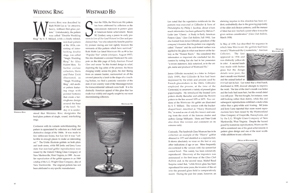50 Favorites:
Early American Pressed Glass Goblets
Selections from the Dorothy & Jacque D. Vallier Collection
Introduction and Essays by Kirk J. Nelson
Exhibition Curator and Project Director Renee G. Gouaux

Making a Catalogue
This catalogue, illustrated with examples from the magnificent collection of Dorothy and Jacque Vallier, consolidates and updates information relating to 50 popular goblet patterns. Entries trace the coverage each pattern has received in books and periodicals from the 1920s to the present and suggest some of the criteria collectors consider when assessing each pattern's relative merit. Consensus served as an interesting and revealing method to determine which goblets to include here.
Notice of the project was published in collectors' trade journals and newsletters. A total of 101 individuals submitted ballots, including collectors, authors, museum curators, dealers, and other specialists. Geographically, the participants represent a diverse cross-section of the country. New England states accounted for 27 ballots. Another 27 came from Midwestern states Iowa, Michigan, Illinois, Wisconsin, Indiana, and Ohio. New York, Pennsylvania, Maryland and New Jersey provided 23 responses. Ten ballots were returned from such western states as California, Arizona, Kansas, Utah, Nebraska, and Texas. Another ten came from southeastern states and four from Canada. Tabulated results identified the catalog's "50 favorites." These have been listed by rank in an appendix together with all other patterns chosen by 5 percent or more of survey participants.
In considering the results of the ballot tabulation, it is interesting to note that the most popular pattern, Horn of Plenty, was chosen by approximately 60 percent of the participants. This means, conversely, that almost half the participants did not even list the foremost pattern among their first 50 choices.

The current survey was not intended to identify the 'best' goblet patterns. Rather, it recognizes that collecting is, fundamentally, a communal or shared experience. A collector's appreciation for a specific pattern may reflect highly personal or individual factors, but it also grows out of shared cultural values and, in the case of pressed-glass goblets, out of perceptions recorded in a rather large body of literature on the subject.
This communal aspect of collecting allows collectors to enjoy a sense of vicarious pleasure when listening to the stories and seeing the collections of their fellow enthusiasts. Certainly, it heightens our appreciation for the magnitude of Dorothy and Jacque Vallier's accomplishment in assembling their wonderful goblet collection. And it heightens our gratitude to them for their generosity in presenting the collection to the University of Wisconsin–Stevens Point. Through its study, and through the publication of this website and catalogue, we hope goblet enthusiasts may develop a better understanding of their personal preferences and derive still-greater enjoyment from their fascinating pursuit.
